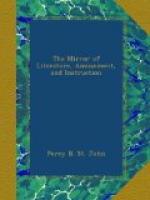MACCLESFIELD BRIDGE.
This picturesque structure crosses the Canal towards the Northern verge of the Regent’s Park; and nearly opposite to it is a road leading to Primrose Hill, as celebrated in the annals of Cockayne as was the Palatino among the ancient Romans.
The bridge was built from the designs of Mr. Morgan, and its construction is considered to be “appropriate and architectural.” Its piers are formed by cast-iron columns, of the Grecian Doric order, from which spring the arches, covering the towing-path, the canal itself, and the southern bank. The abacus, or top of the columns, the mouldings or ornaments of the capitals, and the frieze, are in exceeding good taste, as are the ample shafts. The supporters of the roadway, likewise, correspond with the order; although, says Mr. Elmes, the architect, “fastidious critics may object to the dignity of the pure ancient Doric being violated by degrading it into supporters of modern arches.” The centre arch is appropriated to the canal and the towing-path, and the two external arches to foot-passengers, and as communications to the road above them. Mr. Elmes[1] sums up the merits of the bridge as follows:—“It has a beautiful and light appearance, and is an improvement in execution upon a design of Perronet’s for an architectural bridge, that is, a bridge of orders. The columns are well proportioned, and suitably robust, carrying solidity, grace, and beauty in every part; from the massy grandeur of the abacus, to the graceful revolving of the beautiful echinus, and to the majestic simplicity of the slightly indented flutings.” He then suggests certain improvements in the design, which would have made the bridge “unexceptionably the most novel and the most tasteful in the metropolis. Even as it is, it is scarcely surpassed for lightness, elegance, and originality by any in Europe. It is of the same family with the beautiful little bridge in Hyde Park, between the new entrance and the barracks.”
We are happy to quote the above praise on the construction of Macclesfield Bridge, inasmuch as a critical notice of many of the structures in the Regent’s Park would subject them to much severe and merited censure. The forms of bridges admit, perhaps, of more display of taste than any other species of ornamental architecture, and of a greater means of contributing to the picturesque beauty of the surrounding scenery.
[1] Letter-press to Jones’s “Metropolitan Improvements.”
* * * * *
Tributes to the dead, &c.
(For the Mirror.)
“When
our friends we lose,
Our alter’d feelings alter too our
views;
What in their tempers, teazed or distress’d,
Is with our anger, and the dead at rest;
And must we grieve, no longer trial made,
For that impatience which we then display’d?
Now to their love and worth of every kind,
A soft compunction turns the afflicted
mind;
Virtues neglected then, adored become,
And graces slighted, blossom on the tomb.”




